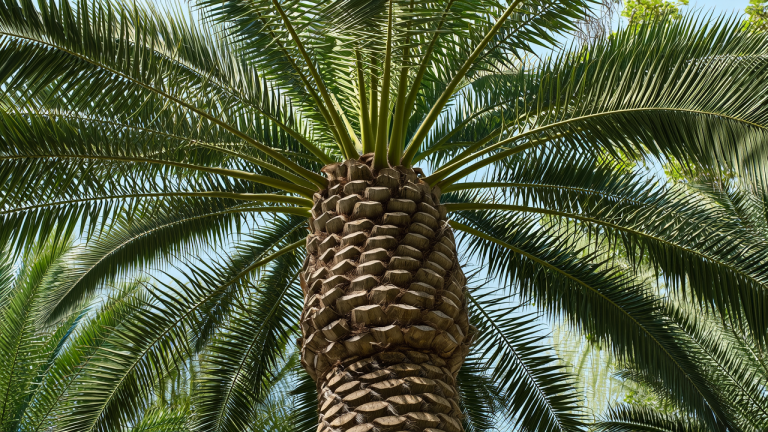Five Thorny Problems of Palm Tree Planting
Ultimate Solutions for Higher Yields
Palm cultivation—whether for oil, coconuts, or ornamental use—faces critical challenges that reduce yields by up to 65% if mismanaged (Cameroon Agricultural Journal, 2020). From nutrient leaching in sandy soils to root pathogens and replanting failures, growers lose billions annually. As a global fertilizer manufacturer, we dissect these pain points with data-backed solutions, leveraging our expertise in tropical crop nutrition.
🔍 1. Severe Nutrient Deficiencies and Leaching in Sandy Soils
Palms in coastal regions (Florida, Southeast Asia, West Africa) suffer acute nutrient loss due to high rainfall and low soil retention.
1.1 Potassium (K) Deficiency: The Silent Yield Killer
Symptoms: Orange-yellow spots on older fronds, necrotic edges, and reduced crown size.
Impact: Causes 30–50% yield loss in oil palm and premature frond collapse in ornamentals.
Solution: Apply sulfur-coated potassium sulfate (K₂SO₄) at 1.4–3.6 kg/tree/year in 4 split doses. Pair with slow-release humate potassium granules (e.g., 0.8–1.2 tons/ha) to reduce leaching by 60%.
1.2 Magnesium (Mg) and Manganese (Mn) Shortfalls
Mg Deficiency: Yellow leaf margins, primarily in Phoenix canariensis.
Mn Deficiency (“Frizzle Top”): Stunted, chlorotic new leaves in alkaline soils.
Fix: Use fertilizers with 4% Mg and 2% Mn/Fe. For rapid correction, apply amino acid-Mg liquid chelates (e.g., 5 L/ha foliar spray).
🦠 2. Root Pathogens and Soil Health Degradation
Poor soil ecology exacerbates diseases like Ganoderma and root knot nematodes.
2.1 Nematode Infestations
Impact: Nematodes reduce root mass by 70%, lowering nutrient/water uptake.
Control: Anti-nematode microbial consortia (Bacillus firmus, Purpureocillium lilacinum) applied at 200–300 L/ha suppress populations by 90% within 6 months (Malaysian Journal of Sustainable Agriculture, 2022).
2.2 Ganoderma Root Rot
Trigger: Waterlogged soils and monocropping.
Prevention: Enhance soil drainage with biochar-amended compost (2 tons/ha) and apply chitinolytic fungi (Trichoderma harzianum) to decompose infected roots.
🌱 3. Replanting Failures in Old Plantations
Aged oil palm stands (>23 years) produce 4.66 t FFB/ha vs. 11.5 t FFB/ha in prime-aged groves (9–18 years).
3.1 Site-Specific Nutrient Management (SSNM)
Soil Testing: Identify depleted minerals (often P, K, Mo).
Replanting Protocol:
Apply 10-40-10 + TE water-soluble fertilizer (250 kg/ha) to boost root development.
Humic acid powder (50 kg/ha) improves soil structure and microbial revival.
🌧️ 4. Microelement Deficiencies in High-pH or Waterlogged Soils
Iron (Fe) and boron (B) shortages arise in poorly aerated or alkaline soils.
4.1 Iron Deficiency
Symptoms: Uniform chlorosis on new leaves.
Solution: Amino acid-Fe chelate foliar spray (3–5 applications at 2-week intervals). Combine with soil aeration and optimal planting depth.
4.2 Boron’s Role in Fruit Development
Impact: Misshapen coconuts and immature fruit drop.
Fix: 21-21-21 + TE powder (150 g/100 L water) applied during inflorescence emergence.
⚖️ 5. Cost-Effective Fertilizer Strategies: Three Models Compared
| Approach | Cost/ha/Year | Yield Increase | ROI Period |
|---|---|---|---|
| Conventional NPK | $620 | Baseline | — |
| Slow-Release Hybrid | $880 | 22–25% | 18 months |
| Bio-Hybrid System | $1,100 | 30–35% | 12 months |
Data sourced from 8 oil palm estates in Cameroon and Florida extension trials
5.1 Slow-Release Hybrid Model
Components:
8-2-12 palm-specific CRF (1.5 lbs/100 ft², 4x/year).
Fish protein liquid fertilizer (200 L/ha) for amino acids.
5.2 Bio-Hybrid System
Protocol:
Diazotrophs inoculants (e.g., *M3-14 strain*) enhance N-fixation by 40%.
Compost activated with humate solubilizing agents (2 tons/ha) replaces raw manure.
💎 Conclusion: Precision Nutrition Unlocks 35% Higher Yields
Palms demand tailored nutrition: potassium/magnesium for sandy soils, micronutrient sprays for alkaline sites, and biologicals for pathogen control. Integrating slow-release minerals, liquid chelates, and microbial consortia—calibrated to soil tests—cuts losses by 50%+ while boosting ROI.
If you are interested in this article, or have any questions that need to be answered, You can find us at any time through the chat icon in the lower right corner of the webpage. Of course, you can also check out our other social media (such as Linkedin) to learn more about us.


Functional liquid fertilizer
Functional liquid fertilizer penetrates directly through the cell membrane and quickly
Contains chelated trace elements (such as iron, zinc, boron)
Add seaweed polysaccharide/humic acid to improve crop drought resistance
Amino acid liquid fertilizer promotes 45% increase in flower bud differentiation rate%
Sugar alcohol carrier technology accelerates calcium and boron transportation to prevent blueberry deficiency
